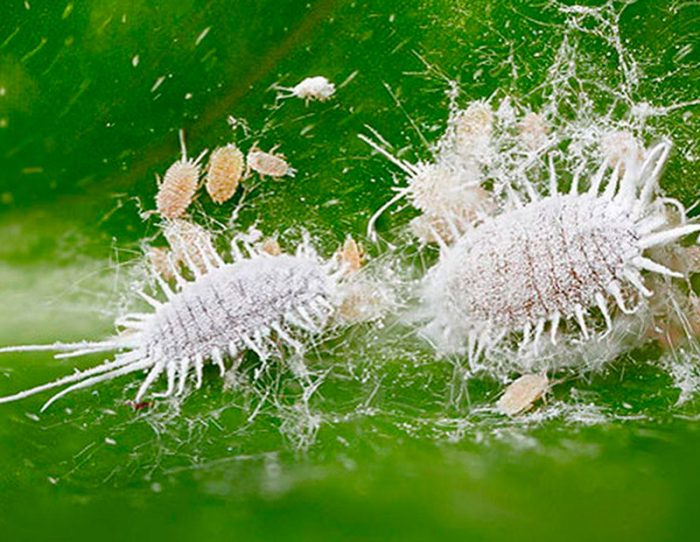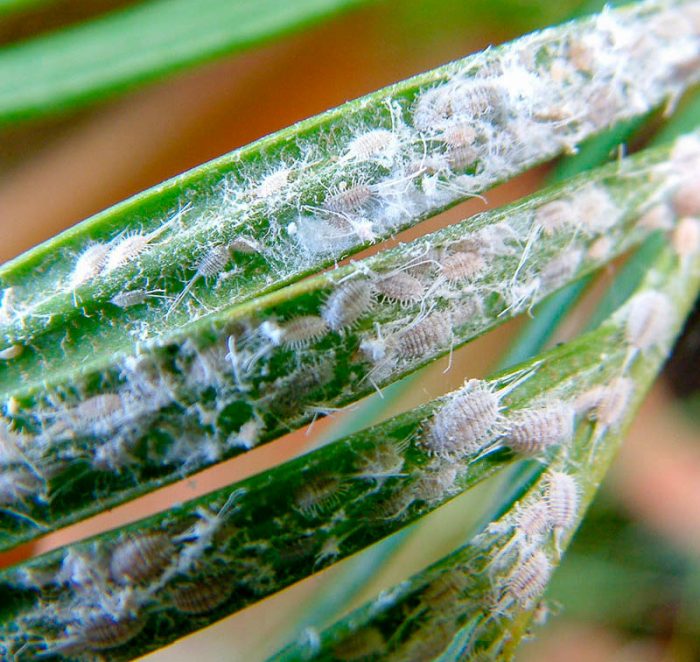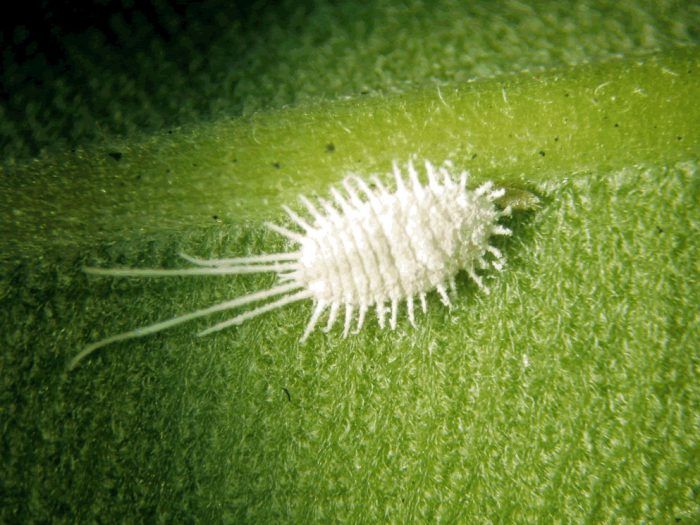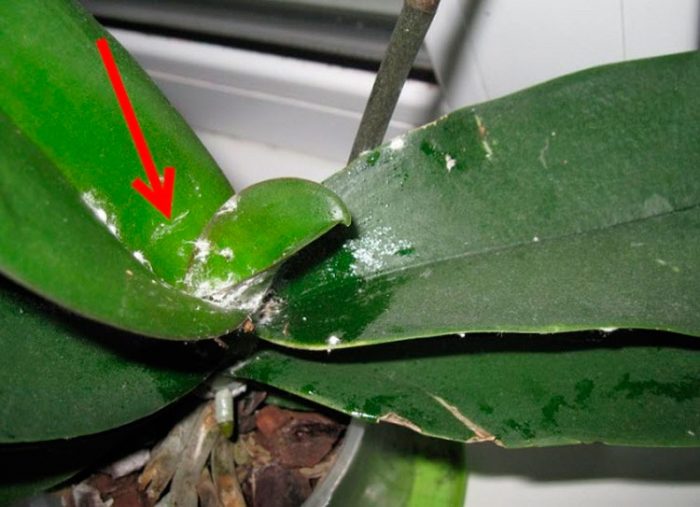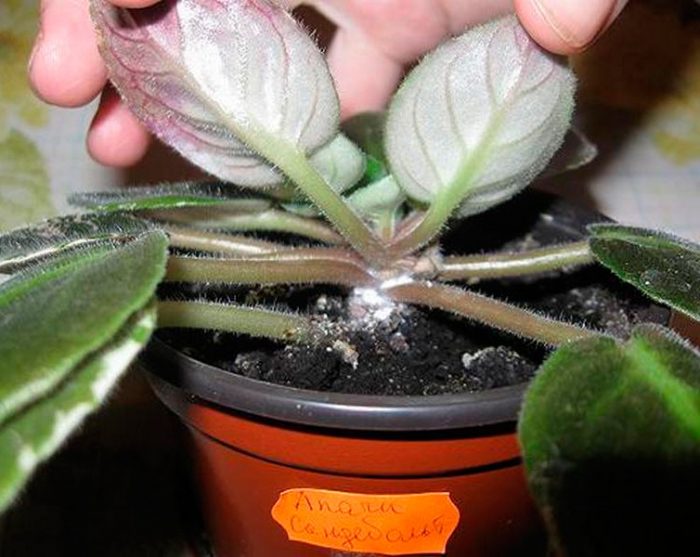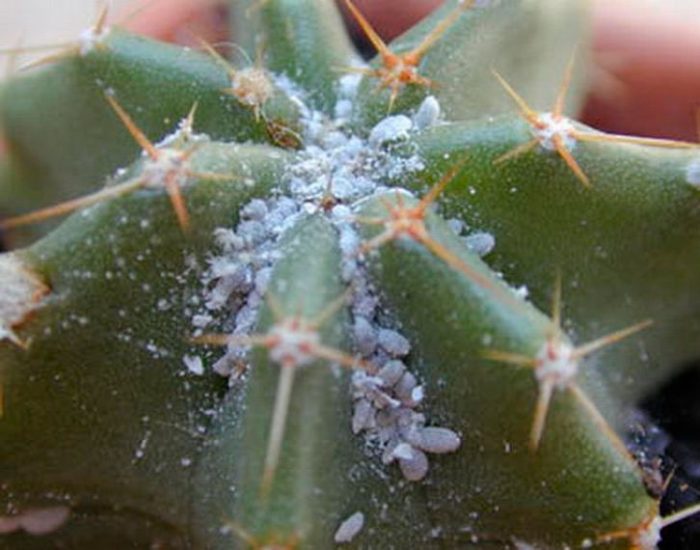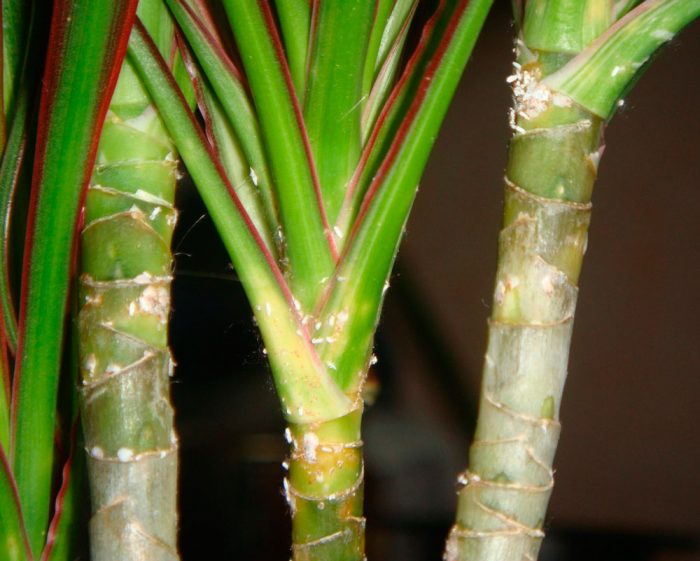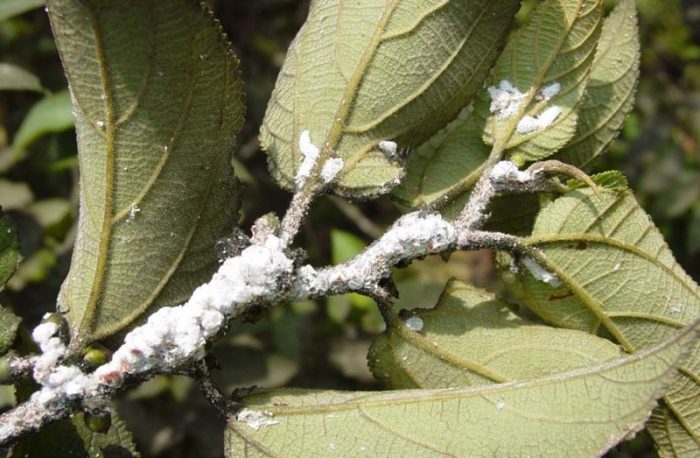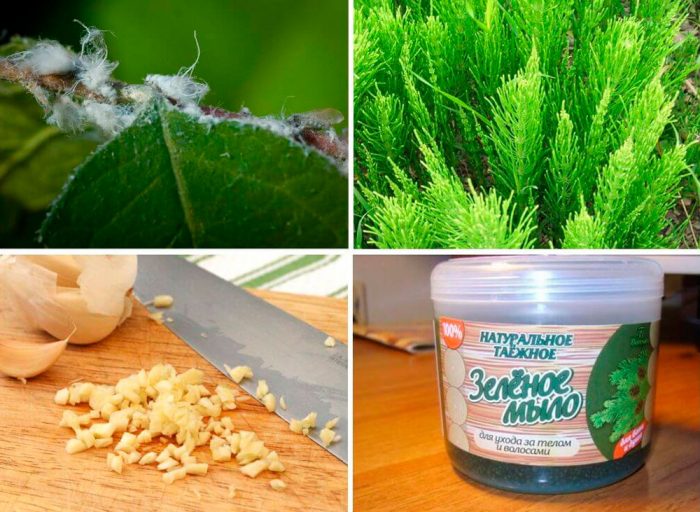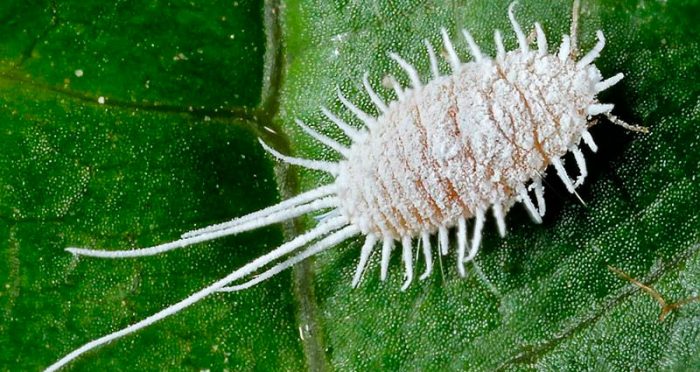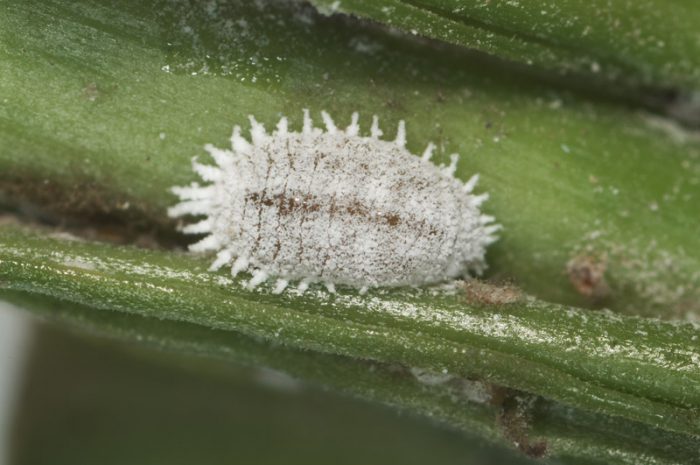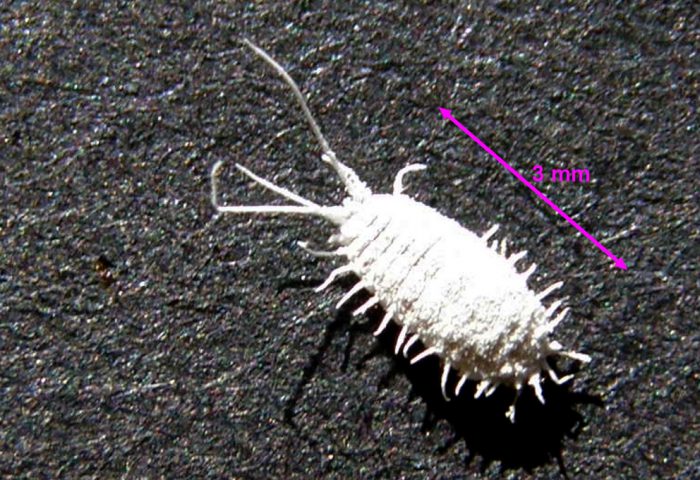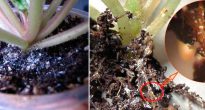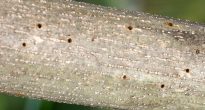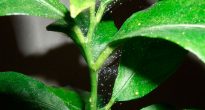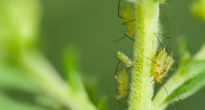Mealybugs (Pseudococcidae), either felt or false pillows, are a family of hemiptera insects that unites more than 2,200 species. On the territory of Europe, you can find only 330 species of worm. Such an insect is very widespread, and it can harm greenhouse, fodder and indoor crops, even succulents and cacti. The people also call this insect "hairy lice".
Content
Features of mealybug
The mealybug is a fairly large insect with a characteristic appearance. Despite the fact that this insect can be easily seen without special equipment, many novice flower growers notice it too late, which makes it very difficult to get rid of such a pest.
The length of the insect varies from 0.3 to 1 cm. The male and female can be easily distinguished externally. The body of the female is oval; it is covered with white powder wax, she has a threadlike long mustache and a large number of short legs. The larva of the pest is outwardly similar to the female, but it is much smaller. Males are a winged insect that looks like a mosquito or a fly. Males have no oral apparatus, so they cannot harm the plant.
Why are worms dangerous for plants? Such sucking insects use the plant cell sap as food. The growth of the bush, on which the pests have settled, at first becomes slower, then the plant stops growing and developing altogether. As a result of their vital activity, such pests emit honeydew, or honeydew, which is a sticky sweet liquid. The pad is a favorable environment for the development of various fungal diseases, and most often a sooty fungus settles on it. Such an insect injures all organs of the plant (both the root system and the aerial parts) and can easily move to another bush located nearby. The most common types are such as: greenhouse lamellar, bamboo, citrus, seaside, grape, Australian grooved, root, bristly and Comstock.
Preventive treatment
In order for the worms not to settle on the plants, one must not forget about the following preventive measures:
- Inspect the bushes regularly, paying particular attention to the sinuses, the back of the leaves, and the buds.
- Trim or tear off dried stems, buds, leaf blades and branches in time, as these can attract harmful insects.
- Water your crops properly. Watering should be systematic and sufficient.
- It is very helpful for indoor plants to have a warm shower.
- Any new indoor flower is quarantined for at least 15 days. To do this, it is removed away from the rest of the houseplants and is necessarily sprayed with an insecticidal solution for prevention purposes.
The most favorable environment for worms is warm (above 25 degrees) and high humidity. If your flower is grown in such conditions, then you need to inspect it regularly for insects.
Mealybug remedies (drugs)
In order to get rid of mealybugs that have settled on plants, as a rule, various insecticidal preparations are used. The following insecticides cope best with such a pest:
- Admiral... This hormonal drug has an intestinal contact effect. Its main active ingredient is pyriproxyfen.
- Aktara from mealybug... In this agent of intestinal action, thiamethoxam is the main active ingredient.
- Actellic... Organophosphate non-systemic insectoacaricidal agent of intestinal action. Its main active ingredient is pirimiphos-methyl. The product is very toxic, so you cannot work with it indoors.
- Apploud... In this drug, the active ingredient is buprofezin.
- Bankcol... The main active ingredient of such a means of intestinal action is bensultap.
- Biotlin... A systemic drug with an intestinal action. Its main active ingredient is imidacloprid.
- Bitoxibacillin... Such a biological agent is distinguished by insectoacaricidal properties; it is used to protect crops from harmful insects.
- Inta-vir... This drug has a broad spectrum of intestinal action, the main active ingredient is cypermethrin.
- Commander... Systemic drug of intestinal action. Its active ingredient is imidacloprid.
- Confidant... In such a systemic agent of intestinal action, the main active ingredient is imidacloprid.
- Mospilan... This systemic agent is distinguished by its intestinal contact action, its active ingredient is acetamiprid.
- Tanrek... This broad-spectrum systemic drug for intestinal action has such a main active ingredient as imidacloprid.
- Fitoverm... This insectoacaricidal agent of biological origin is distinguished by its intestinal contact action, its main active substance is aversectin.
In addition to these drugs, insecticides such as Dantop (Ponche, Apache), Vertimek, Spark Double effect, or Calypso can be used to get rid of mealybugs.
Mealybug on indoor flowers
Mealybug on orchids
The mealybug can settle on dracaena, ficus or even a cactus, but most often it can be found on flowering plants, for example, on violets or orchids. To understand that a mealybug lives on your flowers, you need to pay attention to the following signs:
- On the aerial parts of the bush, there is a mealy bloom.
- The wilting of the bush is observed, its foliage loses its turgor.
- Sticky spots of honeydew appear on the outside of the plant.
- The plant has white oval-shaped insects.
If you have found at least one of these symptoms, you need to try to get rid of the pest as soon as possible. The first step is to move the orchid away from other plants to prevent the spread of the worm. Add a couple of grams of green soap to half a glass of water and mix everything well.With the resulting solution, thoroughly wipe all the aerial parts of the flower, for this you can use a cotton disc or a sponge. Do not forget about the gaps between the stem and leaf plates, since insects like to settle in them most of all. To rinse the cracks, use a brush that is abundantly moistened in a solution. Also, be sure to rinse the sheet plates on both sides. Then 3 times with a break of 1–1.5 weeks, treat the bush with one of the folk remedies, for example: a decoction of cyclamen, garlic or tobacco infusion. Be sure to treat the orchid all 3 times, even if it seemed to you that the worms disappeared after the first procedure.
If there are a lot of pests, then the plant can be treated with pesticides. In this case, the following insecticides are most effective in combating the pest: Fitoverm, Inta-vir and Bitoxibacillin.


Watch this video on YouTube
Mealybug on violets
The mealybug is very dangerous for violets. It is very difficult to understand that a worm has settled on a bush, since its entire cycle takes place in the soil. However, if it is possible to detect a pest, then getting rid of it will not be easy, because it is ideally protected by the structural features of the body. In this case, it will not work to get rid of the worm with folk remedies, so do not waste time and immediately use a systemic insecticidal drug. The most effective treatment of the flower with Aktellik will be: it is sprayed twice or three times with an interval of 7 days, using a solution consisting of 1 liter of water and 2 milligrams of the product. Such a solution will be able to exterminate pests at all stages of development, but it cannot destroy eggs. Be sure to spray the bush outside.
If it was not possible to get rid of the insect even with the help of Actellik, then you need to pull it out of the pot and remove the entire substrate from the roots. Thoroughly treat the sinuses of the lower leaf plates, stem and roots with a systemic insecticidal agent. Then the violet is planted in a pot filled with new substrate.


Watch this video on YouTube
Cactus
If the growth of a cactus has slowed down significantly, and you cannot understand what the reason is, be sure to inspect its root system. As a rule, a mealybug can be found on fresh growths of the tops of a cactus or other succulent plant, but sometimes it also settles on the root system at the base of the stem, and it can also be found in soil mixture. It is possible to understand that worms have settled on the bush by symptoms such as: deformation of young leaf plates and growth points, and marks of a red or brown hue are also formed at the bite sites.
In order to get rid of the pest, spray the aerial part of the bush three times with an interval of 1.5-2 weeks with a solution of a systemic insecticidal preparation. Every time you process a cactus, do not forget to spill the preparation solution and the substrate in which it grows. Hot water is quite effective in the fight against the worm, for this the bush is pulled out of the pot and thoroughly washed under running hot water (from 45 to 50 degrees), while it is necessary to mechanically remove pests from it and thoroughly wash the root system from the soil mixture. The washed cactus is kept in a solution of a systemic insecticide for several hours (by completely immersing the plant in it), and when it dries up, they are planted in a new disinfected soil mixture.
Of all the pesticides, the most effective in the fight against worms on this succulent were such as: Decis, Apollo, Karbofos, Fufanon, Actellik, Sherpa, and also means based on imidacloprid. If there are very few insects on the bush, then you can try to get rid of them with garlic infusion. It is best to process with a cotton swab.
Dracaena
The fact that a mealybug lives on the dracaena can be understood by the appearance of a white bloom and specks of honeydew on the surface of foliage and shoots.Also, the foliage of the affected bush loses its turgor, brown spots appear, and the stems bend. Heat (above 25 degrees) and excessively high air humidity contribute to the appearance of a harmful insect. To get rid of the pest, you should treat the foliage of the bush and disinfect the substrate in which the flower grows. Of all the pesticides, the Fitoverm solution copes well with the pest on the dracaena, four treatments are carried out with a break of 7 days. You can also get rid of the worm with Confidor's solution, but Aktara's solution copes with the pest most effectively: for processing the foliage, a solution is used at a concentration of 8 grams per 10 liters of water, and the soil mixture in a container is spilled with a solution of 7 grams of the drug on a bucket of water. But before you start processing, you must try to wash off all the pests from the bush or remove them with a cotton swab, which is moistened in a soap solution.
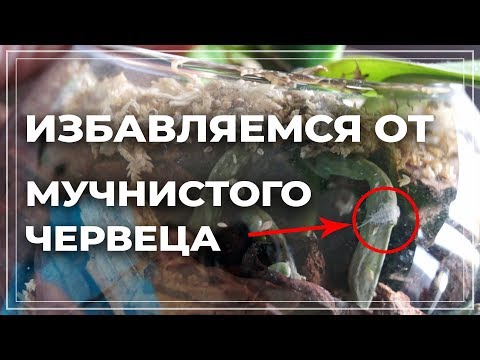

Watch this video on YouTube
Mealybug on horticultural crops
Grape clusters that have become sagging and faded, as well as shreds of white bloom similar to pieces of cotton wool on the aerial parts of the plant are signs that mealybugs have settled on it. As soon as you understand that the grapes are inhabited by this pest, immediately start fighting it. Remember that today there is not a single variety known that would be resistant to such a pest, no matter how sellers assure you otherwise.
For prophylaxis, the bushes are treated in the first days of May, it is at this time that the female scale insects begin to lay eggs. For foliage treatment, systemic insecticidal preparations are used, for example: Aktar, Aktellik, Iskra gold, Mospilan or Confidor. If the pest has occupied the grapes for a long time, then it will not work to cope with it with one spraying. However, if you regularly carry out treatments with systemic insecticides for prophylaxis, then one spraying will be enough to destroy the worm. If ants have settled on your site, it is recommended to destroy them, as they are able to spread both insects and aphids around the garden. In autumn, when preparing a plant affected by a mealybug for wintering, the old bark is removed from it and destroyed by fire.
The fight against this pest on other horticultural crops is carried out by the same methods and preventive measures as in the case of grapes.
Folk remedies
If the berry crops are slightly affected by the mealybug, then to get rid of the pest, it is recommended to use folk remedies that are less toxic than pesticides. For example:
- Oil... A couple of liters of water are mixed with 2 tbsp. l. olive oil. The resulting product is applied to the bushes with a spray bottle.
- Horsetail tincture... This drug can be purchased at the pharmacy, it is used for blood purification and as a diuretic. To process the bush, use a cotton swab, which is moistened in tincture.
- Soap solution with alcohol... 10 milligrams of denatured alcohol and 1 gram of liquid soap are dissolved in one liter of water.
- Garlic infusion... Half a liter of boiling water is combined with four or five garlic cloves, which are pre-crushed. The infusion will be ready after 4–5 hours, it is only filtered and immediately after that processing begins.
- Garlic tincture... Seventy percent alcohol is combined with chopped garlic in a 3: 1 ratio. Processing is carried out using a cotton swab.
- Citrus infusion... In 1 liter of warm water add 50 grams of citrus peels (tangerine, orange or lemon). The infusion will be ready after 24 hours, immediately after it is filtered, they start spraying the bushes.
- Infusion of calendula... One liter of water is combined with 100 grams of dried calendula flowers. After 24 hours, the infusion is filtered, and then it is used to wipe the affected areas.
- Hot water... First, the bush affected by the worms is pulled out of the container, then its root system should be cleaned of the substrate in which pests may be located.Then the whole bush is immersed in warm water for a quarter of an hour (from 45 to 55 degrees). Next, the plant is thoroughly dried and planted in a new disinfected soil mixture.
But remember that folk remedies will be effective only if there are very few pests, either at the initial stage of damage, or for preventive purposes. In the event that there are already a lot of pests on the plant, then the bush must be immediately treated with a systemic insecticidal preparation, since folk remedies will be ineffective and, using them, you can lose precious time.
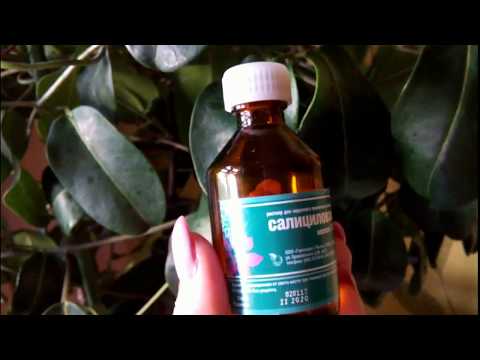

Watch this video on YouTube
Mealybug species
Bristly mealybug (Pseudococcus longispinus)
The plant is harmed directly by larvae and adult females. In length, such a female can reach 3.5 millimeters, and her body, which has the shape of an elongated oval and is painted in pale pink or orange, has a waxy whitish coating. These insects have well-developed legs and therefore they can freely move and move from one plant to another. Females are viviparous. Most often, they accumulate on the seamy side of the leaves, in the leaf sinuses, on the branches, and also on the tops of young stems in the form of colonies. This pest is large and therefore can be easily seen with the naked eye. It has a characteristic powdery coating all over the body, as well as waxy, whitish, cotton-like formations. The leaves, on which the worms settle, turn yellow and die off. The growth and development of shoots slows down. These pests in bulbous plants can crawl under the scales of onions, and in citrus fruits - under the bark. A sooty fungus often settles on the secretions left by the worms.
Grape mealybug (Pseudococcus citri)
On the surface of the body of an adult female, colored yellow or pink, there is a powdery whitish bloom. The body shape is broadly oval. Has developed legs. A small number of males. Young larvae are located throughout the plant. So, they can be seen on the leaves (located along the main veins), on the stems. If the defeat is very strong, then the colony of pests is simply enormous, and they are able to drink all the juice of the plant, thereby destroying it. The foliage turns yellow and the stems dry out. A sooty mushroom settles on the secretions left by pests.
Seaside mealybug (Pseudococcus affinis)
This species is the most common. An adult female has an oval elongated body, in length it can reach 3 or 4 millimeters, and in width - 2–2.5 millimeters. The color is pinkish-gray, and on the surface of the body there is a mealy whitish bloom. Developed legs. Winged males are comparatively smaller and tend to fly throughout the summer. They reproduce by eggs. Their females lay them in special egg sacs, which are a fluffy, whitish mass that has no shape, which consists of arachnoid wax secretions. Most often, before laying eggs, females look for secluded places, for example: twisted leaves, cracks in the bark, a fork in branches, and so on. The mobile small larvae, colored yellow, do not have a wax coating.
These pests in a short time colonize the entire plant, and they can easily be transferred to others, and the wind, animals and even humans help them in this. The larvae become adult worms after 4–6 weeks. They feed on the sap of the plant, sucking it out. As a result, the plant practically stops growing, and then it dies. Infected plants grow extremely slowly and do not bloom. Yellowing and dying off of foliage occurs. Insects leave secretions on which a sooty fungus settles.
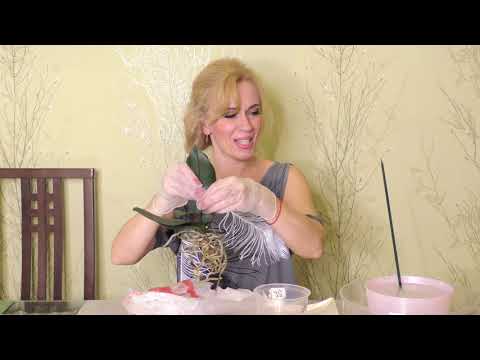

Watch this video on YouTube

